Xiaoqin Zhang
Spatial Preference Rewarding for MLLMs Spatial Understanding
Oct 16, 2025Abstract:Multimodal large language models~(MLLMs) have demonstrated promising spatial understanding capabilities, such as referencing and grounding object descriptions. Despite their successes, MLLMs still fall short in fine-grained spatial perception abilities, such as generating detailed region descriptions or accurately localizing objects. Additionally, they often fail to respond to the user's requirements for desired fine-grained spatial understanding. This issue might arise because existing approaches primarily focus on tuning MLLMs to model pre-annotated instruction data to inject spatial knowledge, without direct supervision of MLLMs' actual responses. We address this issue by SPR, a Spatial Preference Rewarding~(SPR) approach that enhances MLLMs' spatial capabilities by rewarding MLLMs' detailed responses with precise object localization over vague or inaccurate responses. With randomly selected image regions and region descriptions from MLLMs, SPR introduces semantic and localization scores to comprehensively evaluate the text quality and localization quality in MLLM-generated descriptions. We also refine the MLLM descriptions with better localization accuracy and pair the best-scored refinement with the initial descriptions of the lowest score for direct preference optimization, thereby enhancing fine-grained alignment with visual input. Extensive experiments over standard referring and grounding benchmarks show that SPR improves MLLM spatial understanding capabilities effectively with minimal overhead in training. Data and code will be released at https://github.com/hanqiu-hq/SPR
PacGDC: Label-Efficient Generalizable Depth Completion with Projection Ambiguity and Consistency
Jul 10, 2025Abstract:Generalizable depth completion enables the acquisition of dense metric depth maps for unseen environments, offering robust perception capabilities for various downstream tasks. However, training such models typically requires large-scale datasets with metric depth labels, which are often labor-intensive to collect. This paper presents PacGDC, a label-efficient technique that enhances data diversity with minimal annotation effort for generalizable depth completion. PacGDC builds on novel insights into inherent ambiguities and consistencies in object shapes and positions during 2D-to-3D projection, allowing the synthesis of numerous pseudo geometries for the same visual scene. This process greatly broadens available geometries by manipulating scene scales of the corresponding depth maps. To leverage this property, we propose a new data synthesis pipeline that uses multiple depth foundation models as scale manipulators. These models robustly provide pseudo depth labels with varied scene scales, affecting both local objects and global layouts, while ensuring projection consistency that supports generalization. To further diversify geometries, we incorporate interpolation and relocation strategies, as well as unlabeled images, extending the data coverage beyond the individual use of foundation models. Extensive experiments show that PacGDC achieves remarkable generalizability across multiple benchmarks, excelling in diverse scene semantics/scales and depth sparsity/patterns under both zero-shot and few-shot settings. Code: https://github.com/Wang-xjtu/PacGDC.
Exploring 3D Activity Reasoning and Planning: From Implicit Human Intentions to Route-Aware Planning
Mar 17, 2025Abstract:3D activity reasoning and planning has attracted increasing attention in human-robot interaction and embodied AI thanks to the recent advance in multimodal learning. However, most existing works share two constraints: 1) heavy reliance on explicit instructions with little reasoning on implicit user intention; 2) negligence of inter-step route planning on robot moves. To bridge the gaps, we propose 3D activity reasoning and planning, a novel 3D task that reasons the intended activities from implicit instructions and decomposes them into steps with inter-step routes and planning under the guidance of fine-grained 3D object shapes and locations from scene segmentation. We tackle the new 3D task from two perspectives. First, we construct ReasonPlan3D, a large-scale benchmark that covers diverse 3D scenes with rich implicit instructions and detailed annotations for multi-step task planning, inter-step route planning, and fine-grained segmentation. Second, we design a novel framework that introduces progressive plan generation with contextual consistency across multiple steps, as well as a scene graph that is updated dynamically for capturing critical objects and their spatial relations. Extensive experiments demonstrate the effectiveness of our benchmark and framework in reasoning activities from implicit human instructions, producing accurate stepwise task plans, and seamlessly integrating route planning for multi-step moves. The dataset and code will be released.
Data-Efficient Generalization for Zero-shot Composed Image Retrieval
Mar 07, 2025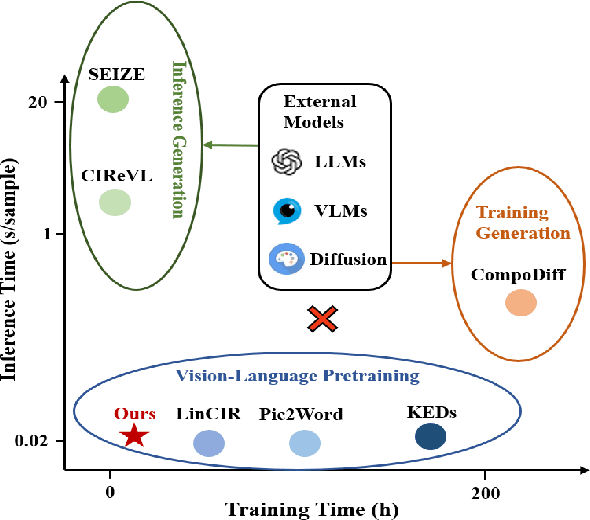
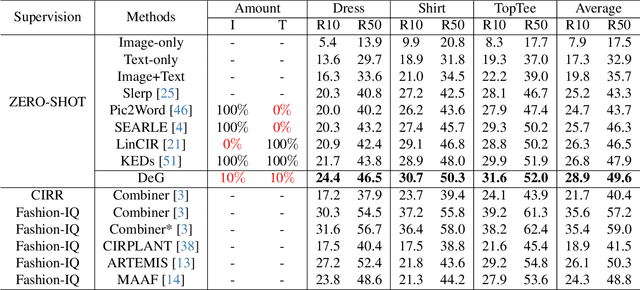
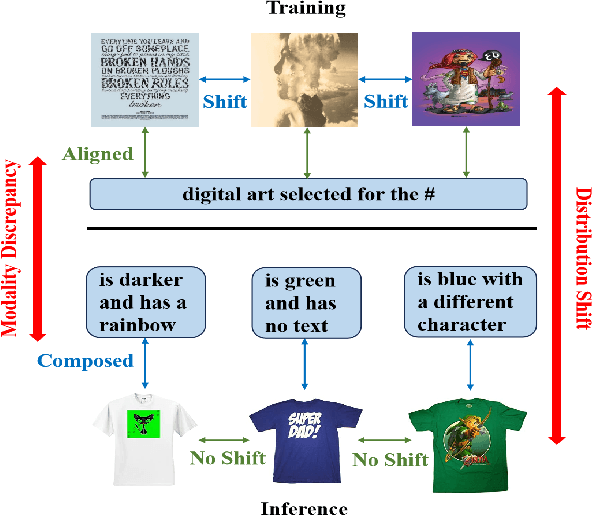
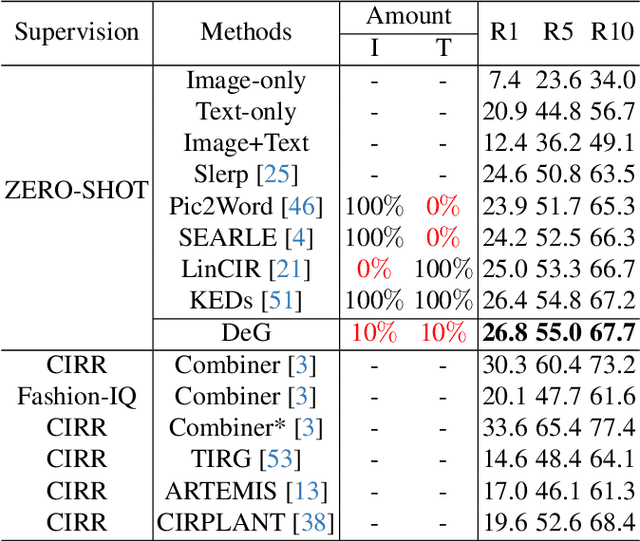
Abstract:Zero-shot Composed Image Retrieval (ZS-CIR) aims to retrieve the target image based on a reference image and a text description without requiring in-distribution triplets for training. One prevalent approach follows the vision-language pretraining paradigm that employs a mapping network to transfer the image embedding to a pseudo-word token in the text embedding space. However, this approach tends to impede network generalization due to modality discrepancy and distribution shift between training and inference. To this end, we propose a Data-efficient Generalization (DeG) framework, including two novel designs, namely, Textual Supplement (TS) module and Semantic-Set (S-Set). The TS module exploits compositional textual semantics during training, enhancing the pseudo-word token with more linguistic semantics and thus mitigating the modality discrepancy effectively. The S-Set exploits the zero-shot capability of pretrained Vision-Language Models (VLMs), alleviating the distribution shift and mitigating the overfitting issue from the redundancy of the large-scale image-text data. Extensive experiments over four ZS-CIR benchmarks show that DeG outperforms the state-of-the-art (SOTA) methods with much less training data, and saves substantial training and inference time for practical usage.
Bringing RGB and IR Together: Hierarchical Multi-Modal Enhancement for Robust Transmission Line Detection
Jan 25, 2025Abstract:Ensuring a stable power supply in rural areas relies heavily on effective inspection of power equipment, particularly transmission lines (TLs). However, detecting TLs from aerial imagery can be challenging when dealing with misalignments between visible light (RGB) and infrared (IR) images, as well as mismatched high- and low-level features in convolutional networks. To address these limitations, we propose a novel Hierarchical Multi-Modal Enhancement Network (HMMEN) that integrates RGB and IR data for robust and accurate TL detection. Our method introduces two key components: (1) a Mutual Multi-Modal Enhanced Block (MMEB), which fuses and enhances hierarchical RGB and IR feature maps in a coarse-to-fine manner, and (2) a Feature Alignment Block (FAB) that corrects misalignments between decoder outputs and IR feature maps by leveraging deformable convolutions. We employ MobileNet-based encoders for both RGB and IR inputs to accommodate edge-computing constraints and reduce computational overhead. Experimental results on diverse weather and lighting conditionsfog, night, snow, and daytimedemonstrate the superiority and robustness of our approach compared to state-of-the-art methods, resulting in fewer false positives, enhanced boundary delineation, and better overall detection performance. This framework thus shows promise for practical large-scale power line inspections with unmanned aerial vehicles.
COMPrompter: reconceptualized segment anything model with multiprompt network for camouflaged object detection
Nov 28, 2024Abstract:We rethink the segment anything model (SAM) and propose a novel multiprompt network called COMPrompter for camouflaged object detection (COD). SAM has zero-shot generalization ability beyond other models and can provide an ideal framework for COD. Our network aims to enhance the single prompt strategy in SAM to a multiprompt strategy. To achieve this, we propose an edge gradient extraction module, which generates a mask containing gradient information regarding the boundaries of camouflaged objects. This gradient mask is then used as a novel boundary prompt, enhancing the segmentation process. Thereafter, we design a box-boundary mutual guidance module, which fosters more precise and comprehensive feature extraction via mutual guidance between a boundary prompt and a box prompt. This collaboration enhances the model's ability to accurately detect camouflaged objects. Moreover, we employ the discrete wavelet transform to extract high-frequency features from image embeddings. The high-frequency features serve as a supplementary component to the multiprompt system. Finally, our COMPrompter guides the network to achieve enhanced segmentation results, thereby advancing the development of SAM in terms of COD. Experimental results across COD benchmarks demonstrate that COMPrompter achieves a cutting-edge performance, surpassing the current leading model by an average positive metric of 2.2% in COD10K. In the specific application of COD, the experimental results in polyp segmentation show that our model is superior to top-tier methods as well. The code will be made available at https://github.com/guobaoxiao/COMPrompter.
Historical Test-time Prompt Tuning for Vision Foundation Models
Oct 27, 2024



Abstract:Test-time prompt tuning, which learns prompts online with unlabelled test samples during the inference stage, has demonstrated great potential by learning effective prompts on-the-fly without requiring any task-specific annotations. However, its performance often degrades clearly along the tuning process when the prompts are continuously updated with the test data flow, and the degradation becomes more severe when the domain of test samples changes continuously. We propose HisTPT, a Historical Test-time Prompt Tuning technique that memorizes the useful knowledge of the learnt test samples and enables robust test-time prompt tuning with the memorized knowledge. HisTPT introduces three types of knowledge banks, namely, local knowledge bank, hard-sample knowledge bank, and global knowledge bank, each of which works with different mechanisms for effective knowledge memorization and test-time prompt optimization. In addition, HisTPT features an adaptive knowledge retrieval mechanism that regularizes the prediction of each test sample by adaptively retrieving the memorized knowledge. Extensive experiments show that HisTPT achieves superior prompt tuning performance consistently while handling different visual recognition tasks (e.g., image classification, semantic segmentation, and object detection) and test samples from continuously changing domains.
LongHalQA: Long-Context Hallucination Evaluation for MultiModal Large Language Models
Oct 15, 2024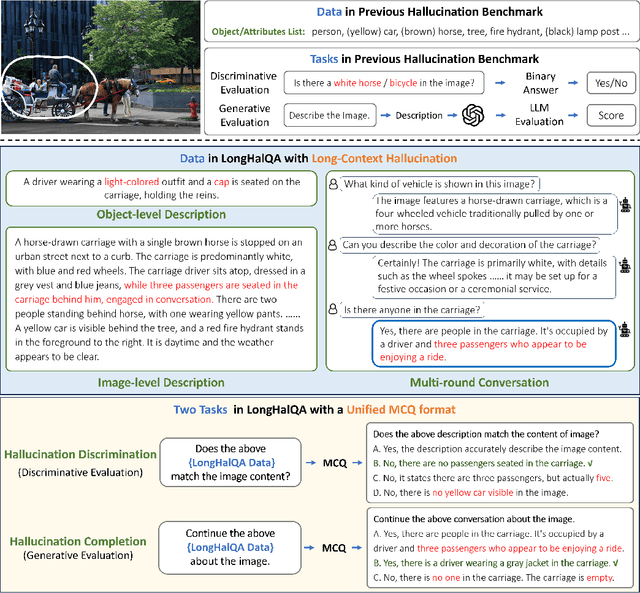



Abstract:Hallucination, a phenomenon where multimodal large language models~(MLLMs) tend to generate textual responses that are plausible but unaligned with the image, has become one major hurdle in various MLLM-related applications. Several benchmarks have been created to gauge the hallucination levels of MLLMs, by either raising discriminative questions about the existence of objects or introducing LLM evaluators to score the generated text from MLLMs. However, the discriminative data largely involve simple questions that are not aligned with real-world text, while the generative data involve LLM evaluators that are computationally intensive and unstable due to their inherent randomness. We propose LongHalQA, an LLM-free hallucination benchmark that comprises 6K long and complex hallucination text. LongHalQA is featured by GPT4V-generated hallucinatory data that are well aligned with real-world scenarios, including object/image descriptions and multi-round conversations with 14/130 words and 189 words, respectively, on average. It introduces two new tasks, hallucination discrimination and hallucination completion, unifying both discriminative and generative evaluations in a single multiple-choice-question form and leading to more reliable and efficient evaluations without the need for LLM evaluators. Further, we propose an advanced pipeline that greatly facilitates the construction of future hallucination benchmarks with long and complex questions and descriptions. Extensive experiments over multiple recent MLLMs reveal various new challenges when they are handling hallucinations with long and complex textual data. Dataset and evaluation code are available at https://github.com/hanqiu-hq/LongHalQA.
Exploring Deeper! Segment Anything Model with Depth Perception for Camouflaged Object Detection
Jul 17, 2024


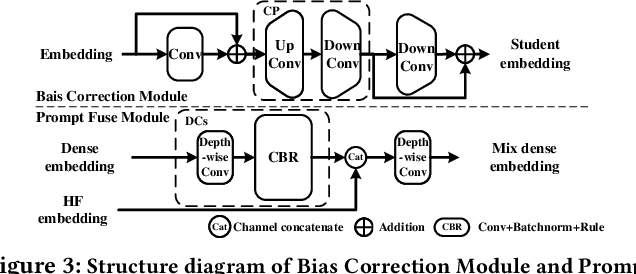
Abstract:This paper introduces a new Segment Anything Model with Depth Perception (DSAM) for Camouflaged Object Detection (COD). DSAM exploits the zero-shot capability of SAM to realize precise segmentation in the RGB-D domain. It consists of the Prompt-Deeper Module and the Finer Module. The Prompt-Deeper Module utilizes knowledge distillation and the Bias Correction Module to achieve the interaction between RGB features and depth features, especially using depth features to correct erroneous parts in RGB features. Then, the interacted features are combined with the box prompt in SAM to create a prompt with depth perception. The Finer Module explores the possibility of accurately segmenting highly camouflaged targets from a depth perspective. It uncovers depth cues in areas missed by SAM through mask reversion, self-filtering, and self-attention operations, compensating for its defects in the COD domain. DSAM represents the first step towards the SAM-based RGB-D COD model. It maximizes the utilization of depth features while synergizing with RGB features to achieve multimodal complementarity, thereby overcoming the segmentation limitations of SAM and improving its accuracy in COD. Experimental results on COD benchmarks demonstrate that DSAM achieves excellent segmentation performance and reaches the state-of-the-art (SOTA) on COD benchmarks with less consumption of training resources. The code will be available at https://github.com/guobaoxiao/DSAM.
CorrMAE: Pre-training Correspondence Transformers with Masked Autoencoder
Jun 09, 2024



Abstract:Pre-training has emerged as a simple yet powerful methodology for representation learning across various domains. However, due to the expensive training cost and limited data, pre-training has not yet been extensively studied in correspondence pruning. To tackle these challenges, we propose a pre-training method to acquire a generic inliers-consistent representation by reconstructing masked correspondences, providing a strong initial representation for downstream tasks. Toward this objective, a modicum of true correspondences naturally serve as input, thus significantly reducing pre-training overhead. In practice, we introduce CorrMAE, an extension of the mask autoencoder framework tailored for the pre-training of correspondence pruning. CorrMAE involves two main phases, \ie correspondence learning and matching point reconstruction, guiding the reconstruction of masked correspondences through learning visible correspondence consistency. Herein, we employ a dual-branch structure with an ingenious positional encoding to reconstruct unordered and irregular correspondences. Also, a bi-level designed encoder is proposed for correspondence learning, which offers enhanced consistency learning capability and transferability. Extensive experiments have shown that the model pre-trained with our CorrMAE outperforms prior work on multiple challenging benchmarks. Meanwhile, our CorrMAE is primarily a task-driven pre-training method, and can achieve notable improvements for downstream tasks by pre-training on the targeted dataset. We hope this work can provide a starting point for correspondence pruning pre-training.
 Add to Chrome
Add to Chrome Add to Firefox
Add to Firefox Add to Edge
Add to Edge